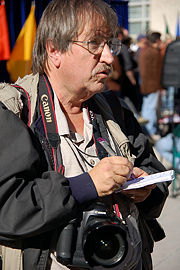How to Break Into Photojournalism
 Like many of the other jobs fields out today, establishing a career in photojournalism
takes time and effort. It's a competitive business, controlled by editors who are often
over-worked and, as if that wasn’t difficult enough, relies a great deal on a certain
amount of subjectivity. In other words, even if you think highly of your photographs,
others might not agree. The following guidelines, however, will help you navigate through
the process of becoming a professional photojournalist.
Like many of the other jobs fields out today, establishing a career in photojournalism
takes time and effort. It's a competitive business, controlled by editors who are often
over-worked and, as if that wasn’t difficult enough, relies a great deal on a certain
amount of subjectivity. In other words, even if you think highly of your photographs,
others might not agree. The following guidelines, however, will help you navigate through
the process of becoming a professional photojournalist.
1. Focus on people. Those trying to make a leap into the profession can start by
shooting photos of people. The basis of photojournalism is the visual documentation of
what is going on around us all. Nothing illustrates that more accurately than photographs
of people doing the things people do.
• The 2008 floods in the American Midwest highlighted this. Countless
photos of flood waters were commonplace on mainstream media wires and hundreds more were
submitted to newspapers every day. What sets the good photos apart from the
ever-increasing stack of common photos, are the people and actions photographed. A photo
of a person feverishly grabbing his belongings before his house floods is almost certainly
going to be a more gripping photo than the one of the flood water and nothing else. At
least, that's the case in the world of photojournalism.
2. Go out on foot patrol. When you're out shooting photographs, get out of your car and
walk. Meet people. Talk to them. Ask them questions. You may be surprised to learn how
many unique story ideas you can come up with just by being curious. Having a unique story
is a quick way to impress an editor, but you will rarely find it driving around in your car.
• It's better to focus on one or two stories that are unique than to
shoot several stories that many other photojournalists are already documenting. Look
around you for opportunities to cover stories that are hidden, or notoriously
exclusive. In other words, invest in quality over quantity.
 3. Be a copycat. Keep an eye on professional photojournalists while they work. Check
your ego and watch how they go about getting their photographs and you may learn a few
things. Even simple things, like how they carry a notebook and pen with them to write
notes and names while on assignment, will give you an edge. They are professionals for a
reason so you can learn plenty from modeling yourself after them. If you’re at an event
professional photojournalists are covering, follow up the next day by looking at their
printed work in the newspaper or website they work for. You can learn a lot by doing this
on a regular basis.
3. Be a copycat. Keep an eye on professional photojournalists while they work. Check
your ego and watch how they go about getting their photographs and you may learn a few
things. Even simple things, like how they carry a notebook and pen with them to write
notes and names while on assignment, will give you an edge. They are professionals for a
reason so you can learn plenty from modeling yourself after them. If you’re at an event
professional photojournalists are covering, follow up the next day by looking at their
printed work in the newspaper or website they work for. You can learn a lot by doing this
on a regular basis.
4. Concentrate on writing good captions. A striking difference between amateur
photographers and professional photographers is the pros have perfected the art of
collecting information about their photographs. Who? What? When? Where? If you can't get
the facts straight, and write them in a clear, concise and accurate caption, you will not
make it far in the business of photojournalism.
| 
